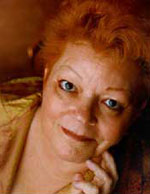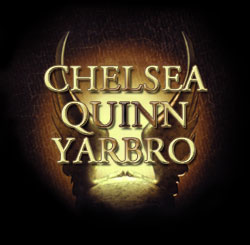
The Stealth Interview
(Fall 2000)
"Long ago it seemed to me -- after reading Dracula at age fourteen -- that there were many worse things than a vampire, and that the human capacity to be hideous to one another was a greater threat than even the most bloodthirsty vampire could achieve. Also, extreme longevity interested me. How could anyone learn to live when all the context of life had gone -- friends, family, culture, language?"
For Chelsea Quinn Yarbro, the answer to her adolescent queries became Count Rogoczy Saint-Germain, the central chracter of a series of books that will soon number fourteen. The Count made his debut in 1978's Hotel Transylvania.
Having decided that vampirism wasn't so bad, Yarbro wanted to see how far she could push the archetype to the positive and still have a recognizable vampire. "A great deal of Dracula's appeal is erotic, as is much of the other vampire literature and legends, and removing the religious bludgeons from the picture made it relatively easy to get to Saint-Germain." (For a more complete view, read the author's essay "From Dracula to Saint-Germain".)
 Chelsea Quinn Yarbro -- and her vampire -- have gained a substantial
following. She has delved into vampiric literature and history in order
to produce cohesive entertaining that combine Saint-Germain's story
with an accurate historical perspective. Far from the bloodsucking
stereotype, Saint-Germain is more honorable, humane, and heroic than
most of the humans around him. The world and its mortal inhabitants are
forces of darkness that Yarbro's vampires must often confront. As one
reviewer wrote, the vampires "serve as a voice of integrity and sanity
in a mortal world filled with death, corruption and dishonesty. In
short, they are often the opposite of the dark creature of the night."
Chelsea Quinn Yarbro -- and her vampire -- have gained a substantial
following. She has delved into vampiric literature and history in order
to produce cohesive entertaining that combine Saint-Germain's story
with an accurate historical perspective. Far from the bloodsucking
stereotype, Saint-Germain is more honorable, humane, and heroic than
most of the humans around him. The world and its mortal inhabitants are
forces of darkness that Yarbro's vampires must often confront. As one
reviewer wrote, the vampires "serve as a voice of integrity and sanity
in a mortal world filled with death, corruption and dishonesty. In
short, they are often the opposite of the dark creature of the night."
Vampire lit-lovers and critics alike have consistently praised Yarbro's
books far more than those of Anne Rice. Ironically, Yarbro notes that
she began writing her first vampire novel in 1971-72 and found a
publisher for it in late 1975. "Hotel Transylvania sold about six
months after Interview with a Vampire sold, but because Signet
sold reverse rights to St. Martin's, Hotel Trans came out
nineteenth months after Rice instead of six months." (Interview
was released on May 5, 1976. It did not become a best-seller until
Ballantine pushed its paperback version a year later.)
Yarbro has placed Saint-Germain's adventures in many eras and locales.
Hotel Transylvania is set in and around Paris in 1743. Other
books have been set as early as Imperial Rome and some stories even
bring Saint-Germain into the 1980s. The first book was set in
mid-eighteenth century for good reason. "It was chosen," Yarbro
explains, "because that was when the real man lived. Then I looked for
historical periods that were interesting to me, when a foreigner could
fit into society, when access to women was possible (St.-G has had male
lovers, but he prefers women -- they're generally more in touch with
their emotions and do not often confuse sex and power.) One of the
reasons I haven't set a book in Africa, other than Egypt, is that there
were few places in society for foreigners except slavery, and St.-G
could not blend in no matter how he tried. I also wanted, if possible,
to have interesting historical characters, when available, or societies
with enough trouble that interesting characters could be invented."
On occasion her creation has "surprised" Yarbro. As a character he has
been known take a book in a different direction than the author
originally planned. "He's a very secretive guy," says Yarbro. "History
imposes a framework, but he has his own way of getting through it."
If Yarbro were to meet Saint-Germain in the flesh, would she succumb to
his immortal charms? "Nope. I like a degree of parity with my romantic
interests, and that 4000 year age gap is a trifle daunting. I also don't
think getting bitten in
the neck is very erotic. You may notice I never say what it is he does,
only that it feels really good when he does it. I would like to have him
as a friend, though, if he existed outside my imagination. You'd be
amazed
at the number of his fans who think he actually does exist outside my
imagination. It's a great compliment, but also a trifle unnerving."
Unlike Yarbro, the Count would be a tough interview. "He's very good at
giving half-answers. He rarely lies, but he equally
rarely does not reveal the whole truth. I would be very surprised if he
told anyone other than a lover very much about himself. At least that's
been his pattern through fourteen books -- and with the fifteenth,
currently in negotiation, I doubt will be any different."
John Clute, in the conclusion of his article of Yarbro in The
Encyclopedia of Fantasy writes that her fiction is "notable for a
sense of advocacy [of the occult]-- a sense that the strangenesses being
described would do the world good if only the world would listen."
Yarbro says. "John is a terrific rationalist, and that he occasionally
sends the left brain to do a right brain job. While I don't disagree
with the notion, I don't see it as a political or persuasive position,
as the latter half of his statement implies, I just think the world is a
great deal stranger than we usually allow ourselves to perceive, and
since I am
writing about a character who is out of time, I would expect him to be
aware of that strangeness, his own social context being long gone. Some
of
my other work -- notably my two lycanthropic novels -- comes at this
perception from a slightly different point of view. After all, aside
from
the Romans, empiricism is a fairly new world view, and a lot of what the
Saint-Germain books are about is clashing world views. What John sees
as occult (and as a serious occultist myself, I disagree with his
definitions of it)
I see as historical socio-cultural cosmologies. But that gets into
abstruse territory very quickly, so I'll stop now."
Abstruse territory? We'd like to go there with Chelsea Quinn Yarbro
ourselves, but the first journey readers should take with her is into
her books. And there's no better place to start than with one of the
books of the Saint-Germain cycle.
